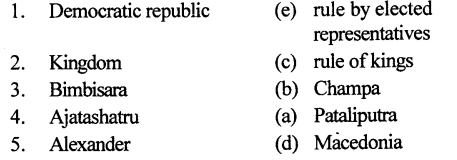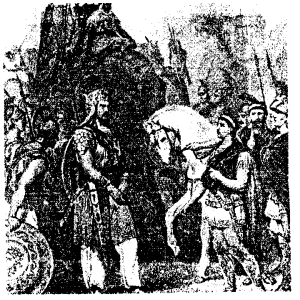The Trail History and Civics for Class 6 ICSE Solutions – The Rise of Magadha
CSE SolutionsSelina ICSE SolutionsML Aggarwal Solutions
The Trail History and Civics for Class 6 ICSE Answers
Trail HistoryCivicsHistory & Civics Geography Biology Chemistry Physics Maths
Keywords
- Janapadas: They were large states that grew in India as a result of wars and conquests. The word means the place where people place their feet.
- Mahajanapadas: They were the powerful Janapadas. There were sixteen Mahajanapadas.
- Shakyas and Lichchhavis: were the name of democratic republics ruled by representatives elected by the people.
- Gandhara School of Art: An Indo-Greek school of art that grew in India as a result of cultural contact with the Greeks.
A. Fill in blanks:
- The pastoral Aryan tribes of the Early Vedic Period roamed about in search of new pastures. In the Later Vedic Period they began to cultivate the land.
- Large kingdoms were known as Janapadas and the more powerful among these were known as mahajanapadas.
- The four powerful kingdom in the Later Vedic Period were Vatsa, Avanti, Kosala and Magadha.
- Alexander invaded India during the reign of the Magadha dynasty.
- India’s cultural contact with the Greeks led to the development of a style of art known as the Gandhara School of Art.
B. Match the following:

Answer:

C. Choose the correct answer:
1. The first important king of Magadha was Bimbisara/ Ajatashatru/Dhana Nanda.
Ans. The first important king of Magadha was Bimbisara.
2. Dhana Nanda was overthrown by Chandragupta Maury a/Bimbisara/Ajatasharu.
Ans. Dhana Nanda was overthrown by Chandragupta Maurya.
3. The capital city of Magadha was Pataliputra/Anga/ Champa.
Ans. The capital city of Magadha was Pataliputra.
4. Ambhi/Ajatashatru/Bimbisara, the ruler of Taxila, offered to help Alexander defeat Chandragupta
Maurya/Porus/Dhana Nanda.
Ans. Ambhi, the ruler of Taxila, offered to help Alexander defeat Porus.
5. Alexander’s invasion led to the establishments of two/ four/eight trade routes by land and sea.
Ans. Alexander’s invasion led to the establishments four trade routes by land and sea.
D. State whether the following are true of false:
- The kingdom of Magadha was established in the Iron Age.
False.
Correct: Magadha belonged to the Later Vedic Age! - Mahapadma Nanda was the last king of the Nanda dynasty.
False.
Correct: Mahapadma Dhana Nanda was the last king of the Nanda dynasty. - Alexander was the king of Rome.
False.
Correct: Alexander was the king of Macedonia. - Ambhi and Porus were allies.
False.
Correct: Ambhi and Porus were enemy. - The power of the small states in north-western India was shattered by Alexander’s invasion.
True.
E. Answer the following questions in one or two words/ sentences:
Question 1.
What were the powerful states in the Later Vedic period called?
Answer:
The more powerful states were called mahajanapadas.
Question 2.
How many mahajanapadas are mentioned in the religious texts of the 6th century bce?
Answer:
There are sixteen manhajanpadas are mentioned in the religious texts of the 6th century bce.
Question 3.
Name the most powerful kingdom in Ancient India (4th century bce).
Answer:
The four powerful kingdom in Ancient India were Vatsa, Avanti, Kosala and Magadha.
Question 4.
What was the Indo-Greek school of art known as?
Answer:
The Indo-Greek school of art known as the Gandhara School of Art.
Question 5.
Name the Mauryan ruler who unified India politically.
Answer:
Chandragupta Maurya.
F. Answer the following questions briefly:
Question 1.
Discuss the developments that led to the emergence of Janapadas.
Answer:
In the Later Vedic period Aryans began to settle down and cultivate land. They used iron tools and implements to clear jungles and bring more land under cultivation. Surplus production led to increased prosperity and the desire to expand further. This in turn resulted in wars and conquests and emergence of large states called janapadas.
Question 2.
Trace the rise of Magadha under the rule of
(1) Bimbisara and
(2) Ajatashatru.
Answer:
- Bimbisara:
The first important king of Magadha was Bimbisara who ruled for 52 years. He expanded his terriotries through conquests and matrimonial alliances making Magadha the most powerful kingdom in those times. The conquest of Anga brought the river port of Champa under his control. - Ajatashatru:
Bimbisara was succeeded by his son Ajatashatru, who ruled for about 32 years. He followed a policy of expansion. He conquered the neighbouring states and made Magadha the most prosperous kingdom in norhtem India. Ajatashatru built a fort in the village of Pataligram which later grew into the capital city of Pataliputra.
Question 3.
How did the conquest of Anga benefit Magadha?
Answer:
The conquest of Anga brought the river port of Champa under the control of Magadha. The rich deposits of iron ore found in this region contributed to the development of a strong and stable economy for Magadha.
Question 4.
Give an account of the causes and results of the battle between Alexander and Porus.
Answer:
Porus was the ruler of the areas lying between the rivers Jhelum and Chenab. Ambhi offered to help Alexander to defeat Porus. Porus fought heroically but was defeated. He was captured and brought before Alexander, who asked him how he would like to be treated. ‘As one king should treat another king’, was his prompt reply. Alexander was so impressed with the reply that he set Poms free and returned all his territories. Alexander and Porus became friends after this.
Question 5.
Why was Alexander unable to conquer Magadha?
Answer:
Alexander was unable to Conquer Magadha because his army refused to advance any further. The army was war- weary and homesick and was not willing to face the powerful army of Magadha.
Question 6.
Describe the effects of Alexander’s invasion.
Answer:
The effects of Alexander’s invasion were following.
- His invasion led to the establishment of four different trade routes by land and sea.
- Alexander’s historians have left dated records of his campaigns.
- The cultural contact with the Greeks led to the growth of the Indo-Greek School of Art known as Grandhara school of Art.
G Picture study.
This is a painting of two famous kings who became friends after a war in the 4th century bce.

Question 1.
Identify the two rulers in this painting ?
Answer:
Alexander and Porus are the two rulers in the painting.
Question 2.
Give an account of the earlier developments that led to this event.
Answer:
Porus was the ruler of the area lying between the rivers Jhelum and Chenab. Ambhi offered to help Alexander to defeat Porus. Porus fought heroically but was defeated. He was captured and brought before Alexandar who asked him how he would like to be treated. Porus replied ‘As one king should treat another king’ Alexandar was so impressed with reply that he set Pours free and they became friends.
Question 3.
Name the most powerful kingdom in India during this time. Which dynasty ruled this kingdom?
Answer:
Magadha was the most powerful kingdom in India during this time. Nanda dynasty ruled this kingdom.
Question 4.
Who overthrew the last ruler of this dynasty ? Name the empire established by him.
Answer:
Chandragupta Maurya overthrew the last ruler of Nanda dynasty. He established Maurya Empire.
OTHER IMPORTANT QUESTION
Question 1.
State the reasons for the emergence of mahajanapadas.
Answer:
Surplus production, increased prosperity and the desire to expand further are the reasons for emergence of the mahajanapadas.
Question 2.
Discuss the causes and results of the battle between Alexander and Porus.
Answer:
Porus was the ruler of the areas lying between the rivers Jhelum and Chenab. Ambhi offered to help Alexander to defeat Porus. Porus fought heroically but was defeated. He was captured and brought before Alexander, who asked him how he would like to be treated. ‘As one king should treat another king’, was his prompt reply. Alexander was so impressed with the reply that he set Poms free and returned all his territories. Alexander and Poms became friends after this.
Question 3.
Why was Alexander unable to conquer Magadha?
Answer:
Alexander was unable to Conquer Magadha because his army refused to advance any further. The army was war- weary and homesick and was not willing to face the powerful army of Magadha.
Question 4.
Describe the effects of Alexander’s invasion.
Answer:
The effects of Alexander’s invasion were following.
- His invasion led to the establishment of four different trade routes by land and sea.
- Alexander’s historians have left dated records of his campaigns.
- The cultural contact with the Greeks led to the growth of the Indo-Greek School of Art known as Grandhara school of Art.